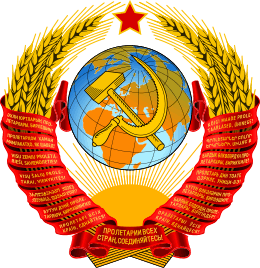Timeline of Smolensk
Prior to 20th century
Historical affiliations
Kievan Rus' 882–1054

Principality of Smolensk 1054–1387
![]()
![]()
![]()
![]()
![]()
![]()
![]()
![]()
![]()
![]()
![]()
Part of a series on the |
||||||||||||||||||||||||||||
|---|---|---|---|---|---|---|---|---|---|---|---|---|---|---|---|---|---|---|---|---|---|---|---|---|---|---|---|---|
| History of Russia | ||||||||||||||||||||||||||||
.svg.png)    | ||||||||||||||||||||||||||||
|
||||||||||||||||||||||||||||
| Timeline | ||||||||||||||||||||||||||||
|
| ||||||||||||||||||||||||||||
- 1137 - Russian Orthodox Diocese of Smolensk established.
- 1150 - Assumption Cathedral consecrated.
- 1408 - Smolensk becomes part of the Grand Duchy of Lithuania.[1]
- 1514 - 1 August: Siege of Smolensk (1514); Moscow in power.[2]
- 1602 - Smolensk Kremlin built.
- 1609 - Siege of Smolensk (1609–11) by Polish forces begins near city.[2]
- 1611 - Siege of Smolensk (1609–11) ends; Poles in power.[2]
- 1613 - Siege of Smolensk (1613–17) begins.
- 1632 - October: Siege of Smolensk (1632–33) begins.[3]
- 1636 - Catholic Roman Catholic Diocese of Smolensk established.[4]
- 1654 - Siege of Smolensk (1654).[1]
- 1667 - Smolensk becomes part of Russia per Truce of Andrusovo.[3]
- 1674 - Assumption Cathedral building demolished.
- 1772 - Assumption Cathedral rebuilt.[1]
- 1812 - August: Battle of Smolensk (1812); city taken by French forces.[1]
- 1878 - Smolenskii Vestnik newspaper begins publication.
- 1885 - Glinka Monument (Smolensk) unveiled.[5]
- 1888 - Smolensk State Museum founded.[6]
- 1894 - Polish church built.[7]
- 1897 - Population: 46,889.
- 1900 - Population: 57,405.[1]
20th century
- 1901 - Tram begins operating.[7]
- 1913 - Population: 76,000.[8]
- 1917 - Labor strikes.[9]
- 1918 - Smolensk State University established.
- 1926 - Smolensk Aviation Plant established.
- 1936 - Zadneprovsky City District, Smolensk of city established.
- 1937
- City becomes part of the Smolensk Oblast.[10]
- Smolensk Oblast Children's Puppet Theatre established.
- 1939 - Smolensk Regional Philharmonic orchestra established.[11]
- 1941 - July–August: Battle of Smolensk (1941).
- 1942 - Cinema opens.[7]
- 1943 - August–October: Battle of Smolensk (1943).
- 1954 - Glinka Festival begins.[12]
- 1961 - Moscow Power Engineering Institute, Smolensk branch established.
- 1963 - Kristall Production Corporation (diamonds) and Smolensk 1100th Anniversary Park established.
- 1965
- Industrial City District, Smolensk established.
- Population: 183,000.[13]
- 1979 - Leninsky City District, Smolensk established.
- 1985 - Population: 331,000.[14]
- 1988 - Smolensk Philharmonic Hall in use.
- 1989 - Population: 341,483.
- 1992 - Football Club Kristall Smolensk formed.
- 1995 - Tvardovsky statue unveiled in Victory Park, Smolensk.
- 1998
- Ivan Averchenkov becomes mayor.
- Aleksandr Prokhorov (politician) becomes governor of Smolensk Oblast.[10]
- 2000 - City becomes part of the Central Federal District.
21st century
- 2002
- Viktor Maslov (politician) becomes governor of Smolensk Oblast.[10]
- Smolensk Archive relocated to Russia from the US.
- 2003 - Vladislav Khaletsky becomes mayor.[15]
- 2004 - Football Club Dnepr Smolensk formed.
- 2010
- 10 April: Airplane crash; Polish president Kaczyński killed.
- Population: 326,863.[10]
gollark: Okay, hold on.
gollark: I MAY.
gollark: Then, none will be safe from mgollark.
gollark: Excellent! When it upgrades *I* can join!
gollark: Well, if you *get* GPT-3 access, I'll send you messages.csv.
See also
- Smolensk history
- Timelines of other cities in the Central Federal District of Russia: Moscow, Voronezh
References
- Britannica 1910.
- Lawrence N. Langer (2002). "Chronology". Historical Dictionary of Medieval Russia. Scarecrow Press. ISBN 978-0-8108-6618-8.
- Lawrence N. Langer (2002). Historical Dictionary of Medieval Russia. Scarecrow Press. ISBN 978-0-8108-6618-8.
- "Chronology of Catholic Dioceses: Russia". Norway: Oslo katolske bispedømme (Oslo Catholic Diocese). Retrieved 30 March 2015.
- Russia & Belarus. Lonely Planet. 2006. ISBN 978-1-74104-291-7.
- "Russianmuseums.info". Russian Cultural Heritage Network. Retrieved 30 March 2015.
- Cohen 2013.
- "Russia: Principal Towns: European Russia". Statesman's Year-Book. London: Macmillan and Co. 1921.
- Hickey 2001.
- "Smolensk Oblast". Territories of the Russian Federation. Europa Territories of the World (13th ed.). Routledge. 2012. p. 78. ISBN 978-1-85743-646-4.
- "История" [History] (in Russian). Smolensk: Смоленская областная филармония (Smolensk Regional Philharmonic). Retrieved 30 March 2015.
- Julie Anne Sadie; Stanley Sadie (2005). Calling on the Composer: a Guide to European Composer Houses and Museums. Yale University Press. ISBN 978-0-300-10750-0.
- "Population of capital cities and cities of 100,000 and more inhabitants". Demographic Yearbook 1965. New York: Statistical Office of the United Nations. 1966.
- United Nations Department of Economic and Social Affairs, Statistical Office (1987). "Population of capital cities and cities of 100,000 and more inhabitants". 1985 Demographic Yearbook. New York. pp. 247–289.
- Ellen Carnaghan (2010). Out of Order: Russian Political Values in an Imperfect World. Pennsylvania State University Press. ISBN 978-0-271-04572-6.
This article incorporates information from the Russian Wikipedia.
Bibliography
- William Coxe (1784), "Smolensko", Travels into Poland, Russia, Sweden and Denmark, London: T. Cadell, OCLC 654136
- "Smolensk", Encyclopædia Britannica (11th ed.), New York: New York : Encyclopaedia Britannica, 1910, OCLC 14782424 – via Internet Archive
- "Smolensk", Russia, Leipzig: Karl Baedeker, 1914, OCLC 1328163
- William Henry Beable (1919), "Smolensk", Russian Gazetteer and Guide, London: Russian Outlook
- Merle Fainsod (1958). Smolensk Under Soviet Rule. Harvard University Press. (research utilizing the Smolensk Archive)
- Michael C. Hickey (2001). "Rise and fall of Smolensk's moderate socialists: the politics of class and rhetoric of crisis in 1917". In Donald J. Raleigh (ed.). Provincial Landscapes: Local Dimensions of Soviet Power, 1917–1953. University of Pittsburgh Press. p. 14+. ISBN 978-0-8229-7061-3.
- Laurie R. Cohen (2013). Smolensk Under the Nazis: Everyday Life in Occupied Russia. University of Rochester Press. ISBN 978-1-58046-469-7.
External links
| Wikimedia Commons has media related to Smolensk. |
- Digital Public Library of America. Items related to Smolensk, various dates
This article is issued from Wikipedia. The text is licensed under Creative Commons - Attribution - Sharealike. Additional terms may apply for the media files.